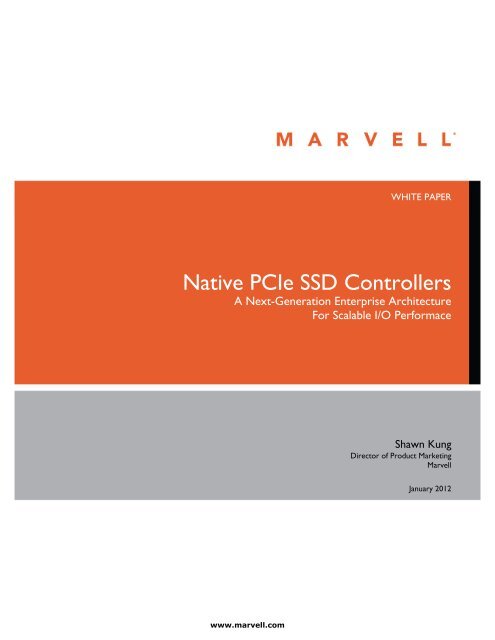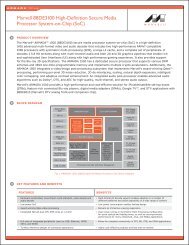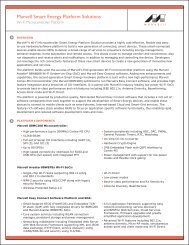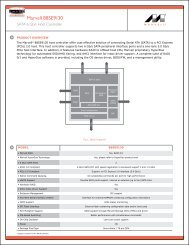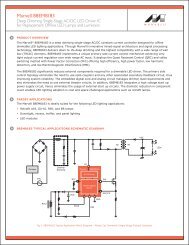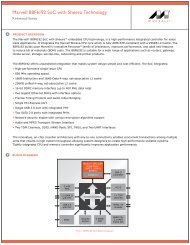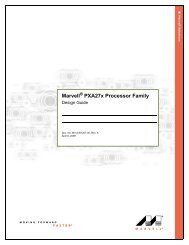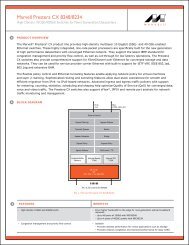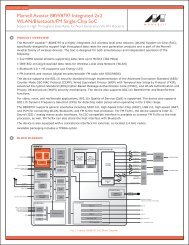Native PCIe SSD Controllers
Native PCIe SSD Controllers - Marvell
Native PCIe SSD Controllers - Marvell
Create successful ePaper yourself
Turn your PDF publications into a flip-book with our unique Google optimized e-Paper software.
WHITE PAPER<br />
<strong>Native</strong> <strong>PCIe</strong> <strong>SSD</strong> <strong>Controllers</strong><br />
A Next-Generation Enterprise Architecture<br />
For Scalable I/O Performace<br />
Shawn Kung<br />
Director of Product Marketing<br />
Marvell<br />
January 2012<br />
www.marvell.com
Overview<br />
Next-generation system architectures are taking advantage of solid state drives (<strong>SSD</strong>s) to eliminate a<br />
growing storage I/O bottleneck exacerbated by the rapid growth of cloud computing and unstructured<br />
data. While CPU, network bandwidth and storage capacity have continued to keep up with<br />
infrastructure growth, storage IOPS (input/output operations per second) from hard disk drives<br />
(HDDs) has not. As a result, a significant and growing storage I/O gap has emerged that hinders the<br />
scalability and quality of service for cloud computing, database and virtualization environments.<br />
<strong>SSD</strong>s offer breakthrough performance advantages over traditional HDDs. For this reason, enterprise<br />
and cloud computing infrastructures are rapidly adopting <strong>SSD</strong>s for applications such as large-scale<br />
distributed web caches, virtual desktop infrastructure (VDI) and online transaction processing (OLTP)<br />
databases. PCI Express (<strong>PCIe</strong>) offers the lowest-latency, highest throughput interface for applications<br />
running on host CPU to take direct advantage of NAND flash. However, current generation <strong>PCIe</strong>-<br />
SAS/SATA and FPGA-based <strong>PCIe</strong> <strong>SSD</strong>s have architectural limitations that may result in performance<br />
limitations and higher costs.<br />
This paper is targeted at <strong>SSD</strong> vendors, server and storage OEMs, and cloud computing architects who<br />
are looking for next-generation <strong>SSD</strong> controller technologies that will provide improved performance<br />
and scalability.<br />
A next-generation solution is offered in the Marvell ® 88NV9145, the world’s first modularly scalable<br />
native <strong>PCIe</strong>-NAND controller. With industry-leading native <strong>PCIe</strong> <strong>SSD</strong> performance, the 88NV9145<br />
solves for the limitations faced by existing bridge and FPGA-based <strong>PCIe</strong> <strong>SSD</strong>s. Furthermore, the<br />
88NV9145 offers a highly configurable architecture for customers to build flexible configurations<br />
to meet the cost, capacity and performance needs of their target customers and market segments.<br />
<strong>SSD</strong> Market Evolution<br />
<strong>SSD</strong>s are rapidly becoming adopted in enterprise and cloud computing infrastructures for applications<br />
such as large-scale distributed web caches, VDI and OLTP databases.<br />
While there has been plenty of industry buzz around <strong>SSD</strong>s, the best days of market growth are still<br />
ahead. Based on a 2011 market analysis by IMEX ® Research, the cumulative <strong>SSD</strong> market over the<br />
next five years is expected to approach $8.6 billion, with the <strong>PCIe</strong> interface as the largest and fastestgrowing<br />
segment. 1 Another analysis by Hitachi ® Global Storage estimates <strong>SSD</strong> unit sales to grow from<br />
under 2M units in 2011 to nearly 7M units by 2015 – during this same period, the <strong>PCIe</strong> <strong>SSD</strong> segment<br />
is projected to grow annual shipments from the low 100K units to nearly 2M units. 2<br />
<strong>SSD</strong>s offer several performance advantages over traditional spinning HDDs, including higher IOPS,<br />
lower latency and higher throughput, as represented by Figures 1, 2 and 3.<br />
1 Slide 26, http://www.snia.org/sites/default/files/AnilVasudeva_Are_<strong>SSD</strong>s_Ready_Enterprise_Storage_Systemsv4.pdf<br />
2 Slide 6, http://www.flashmemorysummit.com/English/Collaterals/Proceedings/2011/20110809_F1C_Collins.pdf<br />
<strong>Native</strong> <strong>PCIe</strong> <strong>SSD</strong> <strong>Controllers</strong> – A Next-Generation Enterprise Architecture For Highly Scalable I/O<br />
2
FIGURE 1: CURRENT <strong>SSD</strong>S TYPICALLY ACHIEVE 100X-1000X HIGHER IOPS THAN HDDS<br />
FIGURE 2: CURRENT <strong>SSD</strong>S TYPICALLY ACHIEVE 10X-100X LOWER LATENCY THAN HDDS<br />
FIGURE 3: CURRENT <strong>SSD</strong>S TYPICALLY ACHIEVE 2X-5X HIGHER THROUGHPUT THAN HDDS<br />
<strong>Native</strong> <strong>PCIe</strong> <strong>SSD</strong> <strong>Controllers</strong> – A Next-Generation Enterprise Architecture For Highly Scalable I/O<br />
3
At a system level, the disruptive nature of <strong>SSD</strong>s is highly beneficial to application workloads where<br />
random I/O is the performance bottleneck. These applications include virtualization, OLTP databases,<br />
big data, content rendering, collaboration suites (e.g. Exchange server), and large-scale web content<br />
caches (e.g. Memcached). <strong>SSD</strong>s are used typically either as a transient cache or persistent data store<br />
to accelerate I/O performance. Many storage systems vendors provide software for automatic caching<br />
or data tiering that migrates hot data from HDDs to <strong>SSD</strong>s (e.g. based on spatial LBA-range or<br />
temporal data forensics).<br />
In virtualization environments (e.g. Citrix ® XenServer, VMware ® ESX, Microsoft ® Hyper-V), the<br />
increasing density of virtual machines (VMs) has created a storage I/O bottleneck commonly referred<br />
to as the I/O blender effect. Both public cloud service providers and private cloud enterprise data<br />
center organizations are facing growing pressure to consolidate more VMs on less hardware to lower<br />
costs. As the number of VMs grows to meet multi-tenant or VDI scaling requirements, the problems<br />
with storage I/O worsen. The reason is while CPU, network bandwidth and storage capacity have<br />
continued to keep up with infrastructure growth, storage IOPS from disk drives has not. As a result, a<br />
significant and growing disk I/O gap has emerged. Fortunately <strong>SSD</strong>s are very well positioned to solve<br />
for this pain.<br />
Limitations of Existing <strong>SSD</strong> Solutions<br />
Current <strong>SSD</strong> suppliers fall into three general segments:<br />
• NAND Vendors – Micron ® , Toshiba ® , SanDisk ® , Intel ® , Samsung ® , etc.<br />
• HDD Vendors – Western Digital ® , Seagate ® , Toshiba ®<br />
• Independent Vendors – OCZ ® , Smart Modular ® , Fusion-io ® , etc.<br />
Within these segments, several <strong>SSD</strong> form factors and interfaces are available, including 2.5” SATA or<br />
SAS <strong>SSD</strong>s in a drive form factor and <strong>PCIe</strong> <strong>SSD</strong>s in a host adapter form factor. Among these options,<br />
<strong>PCIe</strong> <strong>SSD</strong>s currently offer the highest I/O and throughput performance in the market. By connecting<br />
directly to x86 host processors, <strong>PCIe</strong> <strong>SSD</strong>s provide the most direct, low latency path for applications<br />
to access data on these devices. In addition, the adapter form factor of <strong>PCIe</strong> <strong>SSD</strong>s allots more space<br />
for NAND flash and associated controllers, maximizing both <strong>SSD</strong> performance and available capacity.<br />
Existing <strong>PCIe</strong> <strong>SSD</strong>s fall into one of the following categories:<br />
• Bridge-based – <strong>PCIe</strong>-SAS/SATA RAID controller (RoC) + SAS/SATA <strong>SSD</strong>s<br />
• <strong>Native</strong> – <strong>PCIe</strong> to NAND flash; either FPGA or ASIC<br />
While both types of <strong>PCIe</strong> <strong>SSD</strong> architectures offer performance advantages over a single SATA or SAS<br />
<strong>SSD</strong>, there are several advantages of native <strong>PCIe</strong> <strong>SSD</strong>s that make them even more attractive for<br />
next-generation server architectures:<br />
Bridged <strong>PCIe</strong> <strong>SSD</strong><br />
<strong>Native</strong> <strong>PCIe</strong> <strong>SSD</strong><br />
• Latency Low. SAS/SATA protocol overhead Lowest. <strong>PCIe</strong> direct to NAND<br />
• IOPS<br />
Medium-High. Possible RoC<br />
bottleneck<br />
Highest. <strong>PCIe</strong> direct to NAND<br />
• Power Medium. Added RoC power Low (for ASIC design)<br />
<strong>Native</strong> <strong>PCIe</strong> <strong>SSD</strong> <strong>Controllers</strong> – A Next-Generation Enterprise Architecture For Highly Scalable I/O<br />
4
FIGURE 4: EXISTING BRIDGE-BASED PCIE <strong>SSD</strong> APPROACH<br />
FIGURE 5: FUTURE NATIVE PCIE <strong>SSD</strong> APPROACH<br />
Current native <strong>PCIe</strong> <strong>SSD</strong> solutions are primarily based on an FPGA design. While useful for early<br />
adoption, the future of native <strong>PCIe</strong> <strong>SSD</strong>s will almost certainly move away from FPGAs to lower-cost<br />
and higher-performing ASICs. This is because FPGAs simply cannot scale with the increasing demands<br />
of next-generation enterprise server computing technologies. For example, a <strong>PCIe</strong> 1.0 x8 FPGA-based<br />
<strong>SSD</strong> offers 1.6GB/sec (after overhead). Assuming a 256-bit internal data path, this implies the<br />
internal clock needs to run at 100MHz, which is already stressing current-generation FPGAs. At <strong>PCIe</strong><br />
2.0 x8, a CPU clock inside the FPGA would need to run at 200MHz and with new-generation servers<br />
supporting <strong>PCIe</strong> 3.0, an FPGA design just won’t be powerful enough.<br />
Aside from FPGA performance risks and their high cost, another fundamental challenge with an FPGAbased<br />
design is the significant host CPU and memory overhead required to handle wear-leveling<br />
algorithms, garbage collection and other <strong>SSD</strong> management tasks. In an ASIC-based design, the flash<br />
translation layer (FTL) and all NAND processing is offloaded onto powerful embedded CPUs. Instead of<br />
double-digit host CPU overhead (15-30 percent is typical for FPGA designs), an ASIC-based native<br />
<strong>PCIe</strong> <strong>SSD</strong> uses an ultra-thin driver for low single digit host CPU and memory overhead to ensure host<br />
resources are fully available for application processing.<br />
<strong>Native</strong> <strong>PCIe</strong> <strong>SSD</strong> <strong>Controllers</strong> – A Next-Generation Enterprise Architecture For Highly Scalable I/O<br />
5
<strong>Native</strong> <strong>PCIe</strong> <strong>SSD</strong>s – Introducing the Marvell 88NV9145<br />
The Marvell 88NV9145 is the world’s first native <strong>PCIe</strong>-NAND controller that enables incrementally<br />
scalable performance for the enterprise. Marvell has been a trusted supplier to many of the world’s<br />
leading <strong>SSD</strong> suppliers for years and is the first company to offer a native <strong>PCIe</strong>-NAND controller<br />
product to <strong>SSD</strong> and OEM systems vendors. The 88NV9145 is the latest ground breaking SoC by<br />
Marvell that enables customers to scale to over 1 million 4K random IOPS on a single <strong>PCIe</strong> <strong>SSD</strong>.<br />
A brief feature summary of the Marvell 88NV9145:<br />
• <strong>Native</strong> <strong>PCIe</strong>-NAND controller<br />
• Performance<br />
o 4K Random Read: 93,000 IOPS<br />
o 4K Random Write: 70,000 IOPS<br />
o Latency:
FIGURE 7: MARVELL REFERENCE BOARD: PCIE SWITCH WITH 8X 88NV9145 MODULES<br />
FIGURE 8: REFERENCE BLOCK DIAGRAM OF NATIVE PCIE <strong>SSD</strong> USING 88NV9145<br />
The 88NV9145 offers industry-leading native <strong>PCIe</strong> <strong>SSD</strong> performance. By aggregating 16x 88NV9145<br />
modules and a <strong>PCIe</strong> switch on a full-height, half-length <strong>PCIe</strong> rcard, customers can achieve 1.4 million<br />
4K random read IOPS and 1 million 4K random write IOPS. Figure 9 shows the incremental<br />
scalability benefits of the 88NV9145, enabling flexible <strong>SSD</strong> configurations to match the cost, capacity<br />
and performance requirements for target market segments ranging from entry-level to high-end.<br />
<strong>Native</strong> <strong>PCIe</strong> <strong>SSD</strong> <strong>Controllers</strong> – A Next-Generation Enterprise Architecture For Highly Scalable I/O<br />
7
4k Random Read<br />
4k Random Write (clean drive)<br />
1 Module 93 k 1 Module 70 k<br />
2 Module 186 k 2 Module 140 k<br />
4 Module 371 k 4 Module 277 k<br />
8 Module 730 k 8 Module 530 k<br />
16 Module 1.4 Million 16 Module 1.04 Million<br />
FIGURE 9: FLEXIBLE, INCREMENTALLY SCALABLE CONFIGURATIONS USING MARVELL 88NV9145<br />
Summary<br />
Next-generation system architectures are taking advantage of <strong>SSD</strong>s to eliminate a rapidly<br />
growing storage I/O bottleneck. <strong>SSD</strong> manufacturers, server and storage OEMs, cloud computing<br />
providers and many others are adopting <strong>SSD</strong>s to maximize IOPS and throughput, while minimizing<br />
application latency.<br />
<strong>PCIe</strong> offers the most direct, highest performance interface for server applications to take advantage of<br />
NAND flash as either a cache or storage tier. However, current generation <strong>PCIe</strong>-SAS/SATA and FPGAbased<br />
<strong>PCIe</strong> <strong>SSD</strong>s have architectural limitations that result in performance limitations and higher costs.<br />
As depicted by Figure 10, new generation x86 and ARM server processors are projected to shift to<br />
native <strong>PCIe</strong> <strong>SSD</strong>s to resolve these limitations and maximize application-processing performance.<br />
FIGURE 10: ENTERPRISE SHIFT TO NATIVE PCIE <strong>SSD</strong> ARCHITECTURES<br />
The Marvell 88NV9145 is a native <strong>PCIe</strong>-NAND controller that offers industry-leading native<br />
<strong>PCIe</strong> <strong>SSD</strong> performance to solve for the limitations faced by existing bridge and FPGA-based <strong>PCIe</strong><br />
<strong>SSD</strong>s. Furthermore, the 88NV9145 offers a highly configurable architecture for customers to build<br />
flexible designs that meet the cost, capacity and performance needs of their target customers and<br />
market segments.<br />
<strong>Native</strong> <strong>PCIe</strong> <strong>SSD</strong> <strong>Controllers</strong> – A Next-Generation Enterprise Architecture For Highly Scalable I/O<br />
8
As new <strong>PCIe</strong> <strong>SSD</strong> interface standards such as SCSI Express and NVMe are defined, the world’s largest<br />
<strong>SSD</strong> and OEM providers will look to industry leaders like Marvell to provide high-performance, reliable<br />
<strong>SSD</strong> ASIC technology to support the evolution of native <strong>PCIe</strong> <strong>SSD</strong>s.<br />
To learn more about the Marvell 88NV9145 native <strong>PCIe</strong>-NAND controller, please<br />
visit us at http://www.marvell.com/storage/system-solutions/native-pcie-ssd-controller/.<br />
About the Author:<br />
Shawn Kung<br />
Director of Product Marketing<br />
Shawn Kung is Director of Product Marketing at Marvell. He has P&L responsibility for enterprise and<br />
consumer storage products, including innovative systems-level and software solutions in solid-state<br />
storage technology. With more than 12 years of Silicon Valley product management experience, Kung<br />
has spearheaded the product vision for several award-winning products in data storage and data<br />
management. Prior to Marvell, he was senior director of Product Management at Aster Data Systems,<br />
where his vision for integrating MapReduce with MPP clustered databases led the company from an<br />
early stage nine-engineer startup to a $300M "big data" acquisition by Teradata. Prior to Aster Data<br />
Systems, Kung held senior product management positions in core systems at NetApp and enterprise<br />
applications at Oracle Corporation.<br />
Kung received his Bachelor of Arts from the Woodrow Wilson School at Princeton University and a<br />
Master of Science degree in Management Science and Engineering from Stanford University where<br />
he was a Valentine fellow.<br />
<strong>Native</strong> <strong>PCIe</strong> <strong>SSD</strong> <strong>Controllers</strong> – A Next-Generation Enterprise Architecture For Highly Scalable I/O<br />
9
Marvell Semiconductor, Inc.<br />
5488 Marvell Lane<br />
Santa Clara, CA 95054, USA<br />
Tel: 1.408.222.2500<br />
www.marvell.com<br />
Copyright © 2012. Marvell International Ltd. All rights reserved. Marvell, and<br />
the Marvell logo are registered trademarks of Marvell or its affiliates. Other<br />
names and brands may be claimed as the property of others.<br />
<strong>Native</strong> <strong>PCIe</strong> <strong>SSD</strong> whitepaper-001 1/2012<br />
<strong>Native</strong> <strong>PCIe</strong> <strong>SSD</strong> <strong>Controllers</strong> – A Next-Generation Enterprise Architecture For Highly Scalable I/O<br />
10


